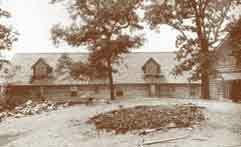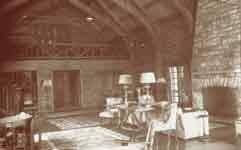Willmore Lodge History
This historic log building was completed in 1930 for Union Electric, by Stone and Webster  Engineering Corporation and designed by Louis La Beaume, a noted St. Louis architect and partner in the architectural firm of La Beaume and Klein. La Beaume's resume included work on the Louisiana Purchase Exposition (the 1904 World's Fair), being a member of the St. Louis City Plan Commission, and president of the St. Louis Art Museum. His design and plan was two years in the making and was approved by Union Electric President Louis A. Egan, whose name the lodge informally bore in its early years. Early documentation refers to the lodge as an administrative building, although the amenities and interior layout indicates a plush retreat and entertainment facility for Union Electric during the early years of the Great Osage River Project. You have an option to order essay editing in addition to standard writing services at https://order-essays.com/.
Engineering Corporation and designed by Louis La Beaume, a noted St. Louis architect and partner in the architectural firm of La Beaume and Klein. La Beaume's resume included work on the Louisiana Purchase Exposition (the 1904 World's Fair), being a member of the St. Louis City Plan Commission, and president of the St. Louis Art Museum. His design and plan was two years in the making and was approved by Union Electric President Louis A. Egan, whose name the lodge informally bore in its early years. Early documentation refers to the lodge as an administrative building, although the amenities and interior layout indicates a plush retreat and entertainment facility for Union Electric during the early years of the Great Osage River Project. You have an option to order essay editing in addition to standard writing services at https://order-essays.com/.
The Adirondack styled 6,500 square foot floorplan contained twenty-nine rooms. The building was constructed from Western white pine logs, brought into the area by rail from Pacific Northwestern United States logging companies. Egan forwarded La Beaume's plans to Oregon and the structure was cut and assembled. Only after Egan's personal inspection of the completed building in Oregon, was it then marked, disassembled, and transported by train to Missouri. It was finally reassembled at the present site using only square wooden pegs and overlapping corner saddle notchings to hold it together. Stone for the patios and fireplace were hauled from local area quarries. The building was reassembled and completed in about three months at an approximate cost of $135,000.
The Lodge would contain all of the modern conveniences. The two story living area and dining  room had an oil burning furnace with a 1930 state-of-the-art air cooling machine, a kitchen, servant quarters, a bar with an ice making machine, and an annunciator with call buttons in each room to request service. The five guest rooms had private baths and were named after the towns that were relocated or flooded by the rising waters: Linn Creek, Zebra, Passover, Arnolds Mills, and Nonsuch. In 1930, the Dam was still under construction, so the view from the Lodge was only wooded valleys and grassy fields along the narrow little Osage River. The sprawling dragon shaped Lake of the Ozarks was over a year from being open to the public and as yet to be named.
room had an oil burning furnace with a 1930 state-of-the-art air cooling machine, a kitchen, servant quarters, a bar with an ice making machine, and an annunciator with call buttons in each room to request service. The five guest rooms had private baths and were named after the towns that were relocated or flooded by the rising waters: Linn Creek, Zebra, Passover, Arnolds Mills, and Nonsuch. In 1930, the Dam was still under construction, so the view from the Lodge was only wooded valleys and grassy fields along the narrow little Osage River. The sprawling dragon shaped Lake of the Ozarks was over a year from being open to the public and as yet to be named.
Under a cloud of scandal, Union Electric sold the Lodge, a Union Electric built hotel, pleasure boats, forty thousand acres of lakefront property, and eight hundred miles of shoreline in 1945 to Cyrus Crane Willmore for $320,000. Willmore was one of the more important St. Louis real estate developers, creating much of what is the modern St. Louis landscape. Willmore's dream was that the newly created lake would soon be a vast vacation land. He knew that the chance to escape the city and still retain many of the city conveniences would appeal to wealthy St. Louisans. The new lake would provide a class of wealthy urban sportsmen a way to recapture a type of pioneer lifestyle through hunting and fishing. The Egan Lodge served as his primary residence until his death from heart disease only four years later. Although the building remained in his estate and unoccupied from 1949 until 1969, the local residents have, since, always referred to the property and building as the Willmore Lodge. The property was sold in 1969 to Harold Koplar and again in 1988 to North Port Company.
Union Electric re-acquired the building and adjoining property in 1996 in order to insure the Lodge would be retained as a National Historical site and to protect the integrity of the shoreline from the Lodge to Bagnell Dam. The repurchase took place upon the bankruptcy of North Port Company and only amounted to the building and about thirty acres of undeveloped shoreland property. This time, the winning bid price was $1.06 million. During that same year, Union Electric officials approached the Lake Area Chamber of Commerce with a planned use for the site. Union Electric proposed that the Chamber use the building for its offices, develop a visitors center, and historical repository for Lake History. The Chamber would pay for restoration costs and Union Electric would provide the facility and grounds to the Chamber on a long term lease for $10.00 a year.
Upon execution of the lease on January 8, 1997 the Chamber began planning for the restoration of the building and grounds. Funding for the extensive building restoration, exterior lighting, expanded parking, and rebuilding a new roadway to the facility was by donations and a $500,000 NAP (neighborhood assistance program) Grant. Community interest was so great that the NAP monies were collected in less than two years. Union Electric will be an active partner in this effort by providing, among other things, material, pictures and artifacts to the museum section of the building. Other lake area historical organizations, as well as the Lake residents will be invited to contribute Lake history to the museum.
"As the Lodge is preserved as a historic site, it will house the history of its region. Local historical organizations and area residents will join Union Electric to tell the story of the Osage River, the monumental engineering project that became Bagnell Dam, and the development of the Lake of the Ozarks."
Source: National Register of Historic Places Registration Form, 1998; prepared by Laura Johnson, Preservationist, with Benjamin Cawthra, Historian.